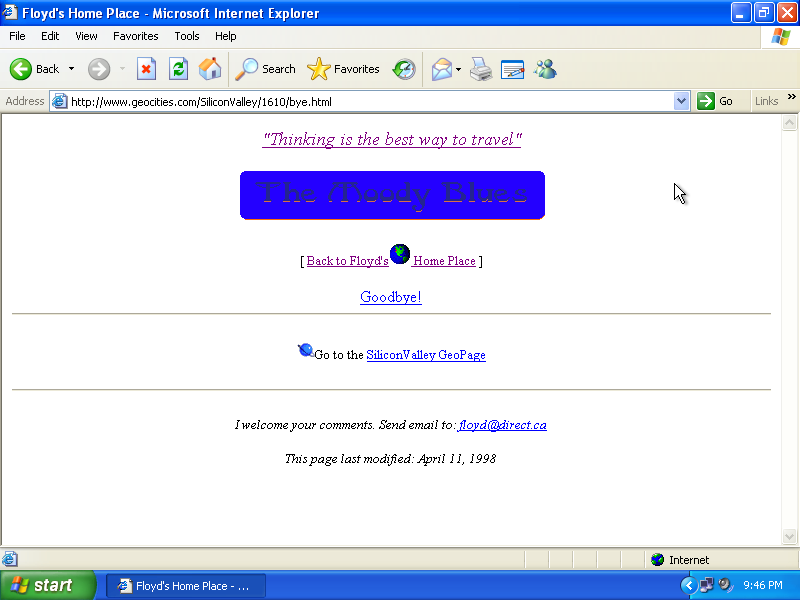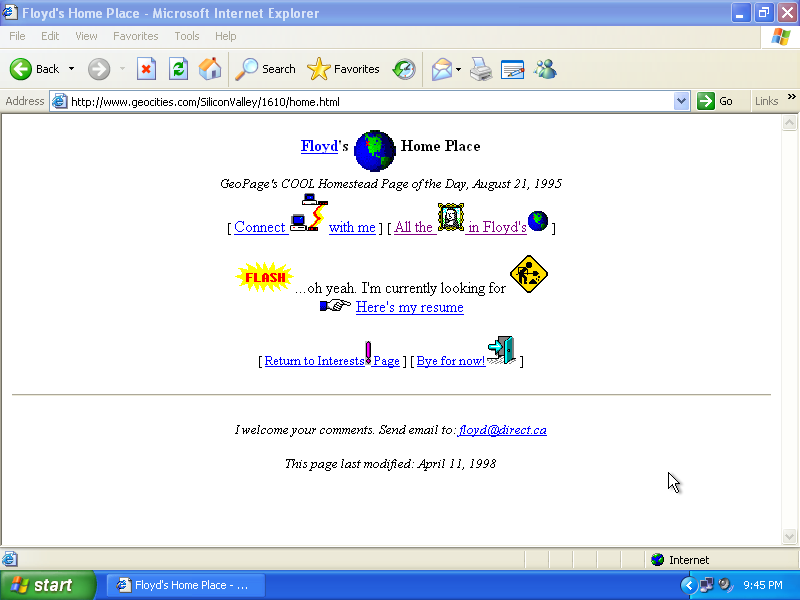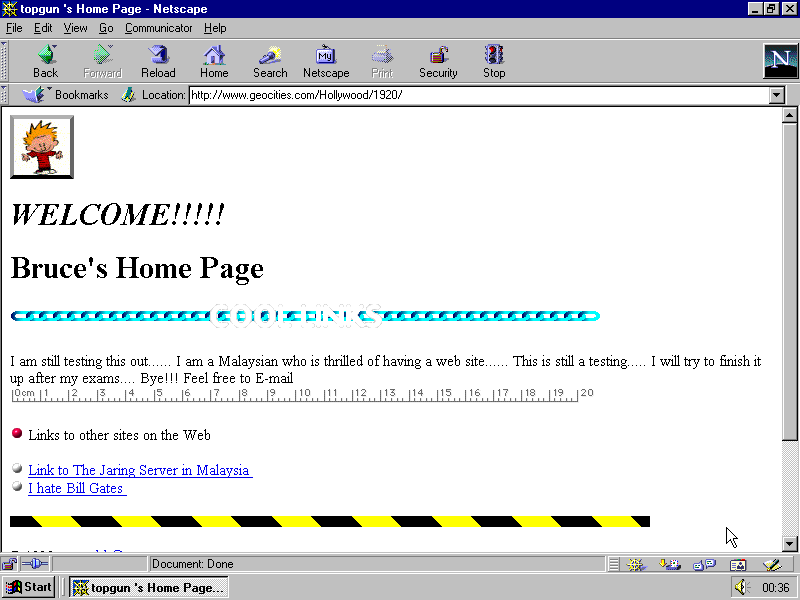Bruce’s Home Page. Part I. “Malaysia’s Bill Gates”
Bruce’s Home Page. Part II. Calvin and Hobbes
Bruce’s home page was the first screenshot published on the One Terabyte of Kilobyte Age Photo Op tumblr blog. Of course that doesn’t mean this is the first page ever made on GeoCities, or even the oldest one in the archive. There are 3 dimensions of time at work here:
- The inception date, when a user first claimed an address on GeoCities and filled out a template or published some files. The best approximation for this time is the earliest last-modified date found on a file in a user’s directory.
- The last modified, when a user stopped updating their GeoCities project. The most effective approximation for this is the last-modified date of the home page, since most users would announce any change to sub pages on their home page. That’s also why these were selected to be screenshotted and made public.
- The posting date, when the screenshot of a home page is appearing on tumblr. Only home pages are posted, in chronological order, according to their abandonment date.
The later a page’s last modified date, the longer the difference to the inception date can potentially be, and the more research is required to understand if content and design of a particular page are tied to the page’s last-modified date or if the page is even older. (More on the complexities of interpreting the last-modified date will be addressed in the upcoming essay “Generation Update”.)
In relation to Bruce’s page this means that there are other pages which were claimed earlier and hence are older, but since they have been updated by their users for longer and where abandoned later, they will also appear much later on the tumblr blog. As I am writing this, pages abandoned in March 2006 appear on tumblr, yet they might have been established many years before.
Let’s forget for a moment the metadata that’s available, and rely only on researchers’ eyes and ears. How can we guess a website’s age? How could we guess Bruce’s Home Page age?
First of all, the size of the graphics, or, more precisely – the width of the images. No ribbon on Bruce’s page is wider than 640 pixels, and hence suitable for 640×480 display resolution, which already became obsolete in 1996. A display resolution of 800×600 pixels established itself as a standard setup during the second part of the 1990’s.
Even if we wouldn’t know that the page was made in 1995 we could state that the page is very old. With “very” I mean older than what we usually consider the canonical GeoCities style that would feature background graphics, animation, table layout, background sound.
Bruce says “Welcome” in written text rather than using an image of the word that would be rendered in 3D, rotate, or glitter. There are under construction signs, but they are not animated. There are no animations at all, and there is no image in the background. The page is silent. No counter, no guestbook, only the default font. It is exactly the aesthetic of transition from “Prof.Dr. Style” to “Geo1996”. The very beginning of substituting semantics with decoration.
Another hint is the URL www.geocities.com/Hollywood/1920/. Knowing that GeoCities handed out numbered addresses to users in chronological order we can conclude that every page in the Hollywood neighborhood with an address containing a lower number than 1920 was established before Bruce’s, but a page’s inception date is even more uncertain than the abandonment date. None of the 141 available home pages in the Hollywood neighborhood referenced with numbers that were supposedly established before Bruce actually contain material that is older.
Continuing with the visual examination, the last line of a page is a critical indicator of age. On Bruce’s page we find a link to the main page of the Hollywood neighborhood. It uses pre GeoCities wording and points to “BHI Hollywood”, meaning “Beverly Hills Internet Hollywood”, not just plain “Hollywood” or “Geocities Hollywood” as it was used in templates later. The missing image ![]() in the last line is also the BHI logo instead of the Geocities logo
in the last line is also the BHI logo instead of the Geocities logo ![]() , as given away by the referenced file name: bhi_logo_tiny.gif is missing on Bruce’s pages, but can be traced in the archive. It was used on 82 other archived pages. Another version of the logo bhi_ball.gif,
, as given away by the referenced file name: bhi_logo_tiny.gif is missing on Bruce’s pages, but can be traced in the archive. It was used on 82 other archived pages. Another version of the logo bhi_ball.gif,![]() which is smaller and probably older lead me to 243 more pages that were established before the company changed its name to GeoCities.
which is smaller and probably older lead me to 243 more pages that were established before the company changed its name to GeoCities.

One of these pages is bye.html, part of Floyd’s Home Place. This page was was last modified on April 11, 1998.
Following the link back to The home.html we see that Floyd’s Home Place was selected to be GeoPage’s COOL Homestead Page of the Day, August 21, 1995.

With archives overall, including the Internet Archive’s Wayback Machine, being far from complete for GeoCities in 1995 here is no way to prove or trace back the award for Floyd’s Home Place, but there is also no reason to assume that the information is false.
Further excavations revealed that “!.gif” or “terrified face” icon ![]() was uploaded to Floyd’s directory as early as August 8, 1995. Which leaves us with a home page that is at least 40 days older than Bruce’s one.
was uploaded to Floyd’s directory as early as August 8, 1995. Which leaves us with a home page that is at least 40 days older than Bruce’s one.
But is it important?
Tracing images, available metadata, personal memories and interviews, and probably other means we discover in the future, could lead to finding the oldest, the first. This is great to satisfy human curiosity and trigger some media attention to the history of the Web. But finding something which can be claimed as the first – be it a page, a graphic, a script, or their creators – has little value for the questions I ask in my work: what does it mean to make a web page? What does it mean to be a webmaster? What did it mean to build the web?
So let’s look at the aspect of Floyd’s Home Place that deals with these questions. There is a significant section on his website called “Pictures used in creating Floyd’s![]() Home Place”. It consists of links to 47 images that were used all over in other sections of the site. It includes a GeoCities icon, a photo of Floyd himself, back and forward navigation icons, and an invisible “spacer” GIF.
Home Place”. It consists of links to 47 images that were used all over in other sections of the site. It includes a GeoCities icon, a photo of Floyd himself, back and forward navigation icons, and an invisible “spacer” GIF.
I don’t remember seeing such a conscious approach to the elements used to build a website before. Maybe because it is indeed very rare to analyze an elaborate website that was made before standards, etiquette and tropes were developed. In my opinion Floyd here gropes for the right way to deal with several new issues. The first one is copyright. Since the majority of the images are found and taken from the other web sites, presenting them together with your own is a way to expose their “in transition status”. Not all of them are yours, but all of them are everybody’s.
Also, what kind of images are they? Illustration? Navigation? Decoration? Signs? All of the above. Floyd didn’t categorize them, as later collections of free graphics would do. Whatever they are, he acknowledged them as web building blocks that helped him, and can help others.
Floyd’s scrupulous collection is a vivid reminder that originally, making your own web page meant to make web pages of others, and to weave the web as a whole.
Floyd noted instructions on how to reveal and download these graphics, which in itself indicates that this must be ancient. Web users did learn very fast how to grab the graphics and codes from other web pages and very soon didn’t require and tips on how to accomplish that.
Another obvious sign of time is the fact that Floyd didn’t embed the graphics into the page but linked to them to save his visitors’ bandwidth. Though all together they are only 125kb, just having 47 images loaded at the same time could have easily overwhelmed browsers and a typical 1995 modem connection. On the top of the page Floyd mentions the 200 kb limit of the web host. That is also prehistory. In autumn the same year the limit was already 1MB. BTW, graphics that Bruce used on his page were not counted agains the limit, since they were the part of the template stored outside of users’ directories.
When Floyd made his web site, the template Bruce used was already available, but he decided not to use it. I want to mention it here not to praise his coding skills but to emphasize that GeoCities allowed it. A premade template was just one of the paths to take to deliver a website to the world. It was possible to work outside of the template’s narrative and extend the horizon of what you were doing. Many users have chosen to welcome their visitors not to their page, but to their “place”, “world, “house”, “castle”, “lair”, “realm”, “universe”.
Floyd’s Home Place is probably the oldest one that survived the great GeoCities extinction. There are many conceptual, structural and visual indicators for its age. But maybe the most unexpected of them is to be found on home.html. It is the classic Under Construction sign (not animated yet) — but it doesn’t refer to the page being under construction, but to its author looking for work.

